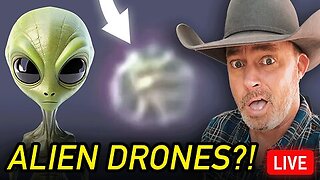Premium Only Content

Alpha Centauri Proxima B and The Closest Exoplanet
Patreon - https://www.patreon.com/user?u=37594401
Buy Me A Coffee? - https://www.buymeacoffee.com/whats.next
Donate With Cash App - https://cash.app/$YTpayments
Get Mentioned In Future Videos By Joining PATREON For As Little As $5 A Month
(and gain access to DOZENS of videos!)
Support Direct Improvements To The Channel With BUY ME A COFFEE
Or Make Direct Contributions With No Strings Attached With CASH APP
Alpha Centauri Proxima A B C D Lost In Space Triple Star System Nearest Closest Elon Musk SpaceX Starship Hubble Space Telescope James Webb Space Telescope JWST 4 Light-years Lightyears Nearest Closest Solar System To Ours Alpha Alfa Centauri Wiki Nearest Star Alpha Centauri is a gravitationally bound system of the closest stars and exoplanets to our Solar System at 4.37 light-years (1.34 parsecs) from the Sun. The name is Latinized from α Centauri, and abbreviated Alpha Cen or α Cen. It is a triple star system consisting of α Centauri A (officially Rigil Kentaurus), α Centauri B (officially Toliman), and the closest star α Centauri C (officially Proxima Centauri).
Alpha Centauri A and B are Sun-like stars (Class G and K, respectively), and together they form the binary star Alpha Centauri AB. To the naked eye, the two main components appear to be a single star with an apparent magnitude of −0.27, the brightest star in the southern constellation of Centaurus and the third-brightest in the night sky, outshone only by Sirius and Canopus.
Alpha Centauri A has 1.1 times the mass and 1.5 times the luminosity of the Sun, while Alpha Centauri B is smaller and cooler, at 0.9 times the Sun's mass and less than 0.5 times its luminosity. The pair orbit around a common centre with an orbital period of 79 years. Their elliptical orbit is eccentric, so that the distance between A and B varies from 35.6 AU (astronomical units), or about the distance between Pluto and the Sun, to 11.2 AU, or about the distance between Saturn and the Sun.
Alpha Centauri C, or Proxima Centauri, is a small faint red dwarf (Class M). Though not visible to the naked eye, Proxima Centauri is the closest star to the Sun at a distance of 4.24 ly (1.30 pc), slightly closer than Alpha Centauri AB. Currently, the distance between Proxima Centauri and Alpha Centauri AB is about 13,000 AU (0.21 ly), equivalent to about 430 times the radius of Neptune's orbit.
Proxima Centauri has three known planets: Proxima b, an Earth-sized exoplanet in the habitable zone discovered in 2016; Proxima c, a super-Earth 1.5 AU away, which is possibly surrounded by a huge ring system, discovered in 2019; and Proxima d, a candidate sub-Earth which orbits very closely to the star, announced in 2022. Alpha Centauri A may have a Neptune-sized habitable-zone planet, though it is not yet known to be planetary in nature and could be an artifact of the discovery mechanism. Alpha Centauri B has no known planets: planet Bb, purportedly discovered in 2012, was found to be an artifact, and a separate transiting planet has yet to be confirmed.
Alpha Centauri Proxima A B C D Lost In Space Triple Star System Nearest Closest Elon Musk SpaceX Starship Hubble Space Telescope James Webb Space Telescope JWST 4 Light-years Lightyears Nearest Closest Solar System To Ours Alpha Alfa Centauri Wiki Nearest Star Alpha Centauri is a gravitationally bound system of the closest stars and exoplanets to our Solar System at 4.37 light-years (1.34 parsecs) from the Sun. The name is Latinized from α Centauri, and abbreviated Alpha Cen or α Cen. It is a triple star system consisting of α Centauri A (officially Rigil Kentaurus), α Centauri B (officially Toliman), and the closest star α Centauri C (officially Proxima Centauri).
Alpha Centauri A and B are Sun-like stars (Class G and K, respectively), and together they form the binary star Alpha Centauri AB. To the naked eye, the two main components appear to be a single star with an apparent magnitude of −0.27, the brightest star in the southern constellation of Centaurus and the third-brightest in the night sky, outshone only by Sirius and Canopus.
Alpha Centauri A has 1.1 times the mass and 1.5 times the luminosity of the Sun, while Alpha Centauri B is smaller and cooler, at 0.9 times the Sun's mass and less than 0.5 times its luminosity. The pair orbit around a common centre with an orbital period of 79 years. Their elliptical orbit is eccentric, so that the distance between A and B varies from 35.6 AU (astronomical units), or about the distance between Pluto and the Sun, to 11.2 AU, or about the distance
Alpha Centauri is the closest star system and closest planetary system to Earth's Solar System at 4.37 light-years (1.34 parsecs) from the Sun. It is a triple star system, consisting of three stars: α Centauri A (officially Rigil Kentaurus), α Centauri B (officially Toliman), and α Centauri C (officially Proxima Centauri).
-
 13:12
13:12
Melonie Mac
21 hours agoAspyr Teases Possible New Tomb Raider Games in Classic Remastered Style
19.1K7 -
 44:49
44:49
Chrissy Clark
15 hours agoThe Rise Of Female Shooters, ABC News’ $16M Settlement, & MORE I Underreported Stories
15.5K4 -
 2:49:13
2:49:13
InfiniteWaters(DivingDeep)
23 hours agoIt's Over - The Matrix Is Cooked | Infinite Waters
16.2K9 -
 15:49
15:49
Chris From The 740
1 day ago $4.63 earnedThe EAA Girsan Influencer X - Not Your Grandpa's 1911
37.1K2 -
 25:38
25:38
Producer Michael
17 hours agoLuxury Souq's MULTI-MILLION DOLLAR Watch Collection!
90.8K5 -
 17:06
17:06
Sleep is CANCELED
22 hours ago10 SCARY Videos To Keep You Up All Night!
59K2 -
 2:37
2:37
Canadian Crooner
1 year agoPat Coolen | Let It Snow!
38.8K9 -
 2:44
2:44
BIG NEM
13 hours agoWhat's Really Behind the Fake Alpha Male Epidemic?
32.6K6 -
 57:20
57:20
State of the Second Podcast
7 days agoThe Inventor of Bump Stock Fights Back! (ft. Slide Fire)
22.7K5 -
 1:04:12
1:04:12
PMG
1 day ago $19.10 earned"I’ll be DRONED for Christmas!"
66.4K12